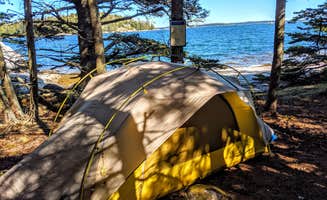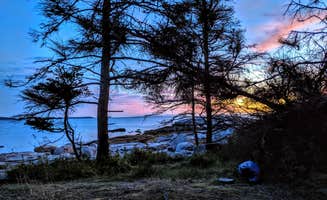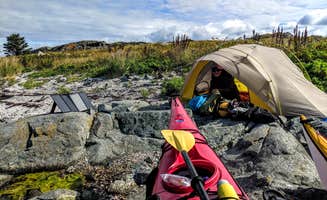Dispersed camping near Coopers Mills, Maine occurs primarily around the Penobscot Bay islands, where the rocky coastline creates natural barriers between camping areas. The Maine coastline in this region features a tidal range of 8-12 feet, creating dramatic shoreline changes throughout the day. These primitive sites require self-sufficiency and preparation for variable weather conditions common to the Gulf of Maine, where fog can reduce visibility to under 100 feet even during summer months.
What to do
Explore nearby Isle au Haut: Wheat Island serves as an excellent base camp for exploring Isle au Haut, a remote section of Acadia National Park. "Perfect island for exploring the close-by Isle au Haut, a remote section of Acadia National Park, but very hard to get reservations at Duck Harbor Campground," notes one Wheat Island visitor.
Nighttime astronomy: The minimal light pollution creates exceptional stargazing opportunities. The Penobscot Bay islands provide unobstructed views of the night sky, including the Milky Way during clear nights. One camper at Buckle Island mentioned having "a gorgeous view of the sun setting" from their shoreline campsite.
Shell collecting: Several islands feature shell-covered beaches with various mollusk species. "Gorgeous shell covered beach and a beautiful view of Isle au Haut, just next door," reports a camper about Doliver Island, making it worthwhile despite limited camping space.
What campers like
Beginner-friendly islands: Some locations provide easier landing conditions for those new to kayak camping. Buckle Island offers "a sandy shore, which is exposed for a good portion of the day, is easy to land on and a short walk to a trail into the woods," making it "perfect for those new to sea kayak camping."
Full moon viewing: The unobstructed eastern horizon provides excellent views of moonrise over the Atlantic. Campers at Wheat Island enjoyed "a gorgeous view of the sun setting and full moon rising" from the southwest camping area, which accommodates larger groups.
Strategic paddling routes: The archipelago enables multi-day island-hopping adventures. Doliver Island serves as "a good stop for us on our 9 day journey and a perfect launching spot for crossing Jericho Bay (4.5 miles) to Marshall Island the next day," according to experienced paddlers.
What you should know
Tide planning critical: Landing conditions vary dramatically with tide levels on certain islands. A Wheat Island camper warns that "this can be a tricky island to land on at high tide, so plan accordingly," a consideration that affects multiple islands in the region.
Mosquito preparation: Bring appropriate insect protection regardless of season. "We thought we were passed mosquito season in early September, but alas, they were pretty bad at sunset," reports one visitor about Wheat Island, while another noted that at Doliver Island mosquitoes "were pretty bad all day long."
Self-contained camping required: No facilities exist on these islands. Campers must "come prepared with fresh water (there is no fresh water for filtering) and wag bags (no toilets)," as one reviewer notes. All sites are "first come, first served and completely free for MITA members."
Tips for camping with families
Choose larger campsites: Some islands offer more spacious sites better suited for groups with children. Wheat Island has two distinct camping areas, including one "perfect for larger groups on the southwest side" with sunset views.
Consider wind protection: Exposed shoreline campsites experience stronger winds, while wooded sites offer better shelter. Buckle Island features "2 sites - one larger area up in the woods, the other quite small near the granite shore," providing options based on weather conditions.
Plan short paddling distances: For families with children, select islands requiring minimal open-water crossings. The proximity of several islands in the Deer Isle Archipelago allows for shorter paddling segments between protected coves.
Tips from RVers
Alternative basecamp options: Since primitive camping near Coopers Mills requires boat access, RVers should consider established campgrounds for vehicle parking while exploring islands by day. Many paddlers launch from public access points after securing their vehicles at mainland campgrounds.
Storage planning: When transitioning from RV to boat-in camping, minimize gear and use waterproof storage. Sea kayaking requires efficient packing techniques, with essential items protected in waterproof bags or containers.
Seasonal considerations: Fall camping offers reduced crowds but requires additional preparation. September visits still encounter insects, as one camper noted, "We thought we were passed mosquito season in early September, but alas, they were pretty bad at sunset."




